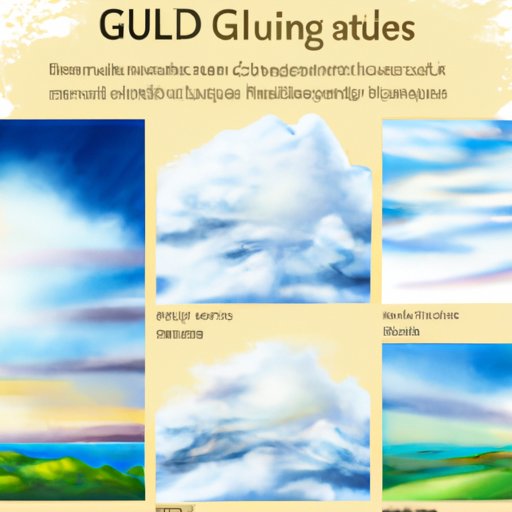Introduction
Painting clouds can seem like an intimidating task. Yet many artists agree that one of the greatest advantages of painting clouds is that they provide artists an opportunity to gain an understanding of light and shadow techniques, and challenges the artist to further develop their artistic skills. This article is intended to help budding artists learn how to paint clouds by simplifying the process into a few simple steps.
The target audience for this article is beginner to intermediate level artists who would like to improve their skill in painting clouds. The goal of this article is to not only teach readers how to paint clouds, but to also encourage experimentation and creativity to make beautiful, unique paintings.
Beginner’s Guide
Painting clouds can be intimidating especially for beginners. Follow these simple steps to paint basic clouds:
- Choose your materials: Acrylic or oil paint work best for painting clouds, and brushes should be of varying sizes to create differing textures.
- Choose a location with plenty of natural light, as this will help you see the light and shadow more clearly.
- Start by sketching your clouds in your painting. You could also opt to paint your entire scene, leaving the clouds for last.
- Paint the base color of the cloud. Clouds at sunrise or sunset are typically pink or orange, while midday clouds are often a blend of white and grey.
- Apply a layer of white paint to the areas where the light would hit the clouds.
- Add shadows, using a light, quick stroke and following a natural, curved shape. Shadows should be grey and appear on the bottom of the cloud.
- Step back and evaluate your work, making any necessary adjustments.
Remember to use broad and light brushstrokes on the sky while keeping your lines loose to create the soft and fluffy characteristic of clouds. To create a successful cloud, try to achieve a balance of whites, grays, and shadows while focusing on the sense of light and shadow.
From Real Life to Canvas
Another method to improve your skills in cloud painting is to observe clouds in real life, paying attention to their composition, color, and shape. You can then apply these elements directly to your canvas.
When starting, it’s important to consider the composition of your clouds. Take note that clouds change with time, so be prepared to adapt your painting accordingly. Find a viewpoint that has little to no obstructions and observe the cloud formations, for instance, the patterns of light and shadow which can be useful for your future works.
Finally, you should always make note of the position of the light source, as this will dictate the shadows cast by the clouds. By doing so, you’ll be able to create more realistic skies in your paintings.
Perfecting Your Technique
As you advance in your skill level, you might find yourself wanting to add more detail and complexity to your cloud paintings. One technique for refining your cloud painting could be to practice adding texture and detail to the clouds.
You can create lifelike, intricate clouds through the use of advanced techniques, such as stippling or the use of natural hair brushes. Creating texture on the cloud surface is the key to giving your clouds depth and realism.
A common mistake of beginners in cloud painting is overworking their painting. It’s important to remember that clouds aren’t completely uniform. They are irregular in shape and texture, so don’t obsess over painting each cloud identically. This will allow your paintings to have a more realistic and natural feel.
Clouds for Landscapes
Clouds play a significant role in landscape painting and can impact the mood and atmosphere of the piece.
The composition of your cloud paintings in landscapes is important, as clouds can either enhance the area or compete for attention. Subtly is important and so the art of blending is something that you should master.
Looking to famous landscape paintings is a great way to develop your cloud painting technique. Paintings like Claude Monet’s “Argenteuil Basin with a Single Sailboat,” or Vincent Van Gogh’s “Starry Night” are great examples of how artists use the sky to enhance their landscapes.
Experimentation and Creativity
Cloud painting can open the door to experimentation and creativity. Consider using unconventional materials for shadowing, or try adding abstract designs to the clouds’ surfaces.
Creative possibilities are endless, and cloud paintings offer the chance for artists to experiment with various techniques while still producing artwork that is easily accessible and understood by viewers.
Conclusion
By following this beginner’s guide and implementing the tips for observation, refining technique, and advancing your artistry, you’ll be painting breathtaking cloud scenes in no time. Properly painting clouds takes time and patience, but the result will be worth it.
Remember to exercise creativity, always observe nature, and practice. Clouds are a source of inspiration and wonder.
